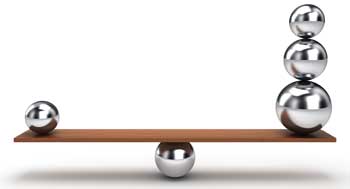As a child, riding a seesaw was fun, wasn’t it? Well, except when you didn’t have equal weight on both sides — then it was just out of balance and someone got stuck in mid-air. That bears the question — is your leadership out of balance? Most likely it is because statistically, more than 85 percent of the population tilts toward being strong at either results or relationships and weak at the other.
What’s Wrong With Being Out of Balance?
The idea of balancing results and relationships is nothing new, but if we assume that character is the foundation of leadership, then there should be an inner motivation to accomplish the mission (get results) and take care of the people (build relationships). If you don’t get results, you can’t be truly successful in your work or justify your purpose and if you don’t take care of your people, some will quit and leave and some will quit and stay. In either case, it’s not a viable situation. So in the long run, balancing a concern for people with accomplishing the mission is crucial to success.
Identify Your Natural Bent
How can you know and what can you do about it? Begin by examining the two columns in the table below and deciding which list of behaviors best describes your “natural” talents. This indicates your natural leadership style and predicts the direction of your tilt as well as the area in which you need to work to improve your balance. If you can’t determine your natural bent, then ask someone who knows you well.
| Results Oriented | Relationship Oriented |
|---|---|
| Take charge, decisive | Encouraging, supportive |
| Introverted, focused | Trusting |
| High standards, task oriented | Good listener |
| Challenging, speaks directly | Gives positive feedback |
| Logical, organized | Concerned and caring |
| Skeptical | Develops others |
How Do You Gain a Better Balance?
First, accept the fact that most of your strengths are natural — we are born with them and naturally out of balance. To get better, we have to change by learning some new personality talents (behaviors). You don’t need to give up who you are, what you have and you don’t need to reinvent yourself. Rather, you augment your strengths by adapting new behaviors that will make you more effective. The way you do this is to intentionally learn a few behaviors in your weaker area that bring you more in balance. The reason this is so hard is that it’s not natural, and therefore often feels very awkward, sometimes hokey and even phony.
Results-Oriented Leaders Need to Soften Up
If this is your style, just the idea of softening seems anathema; but developing good interpersonal skills is what’s needed to make you a better leader. You know it — you just don’t want to go there. For example, learning to patiently listen, really understand, and then affirm the ideas of others can feel very scary. For some, the needed skill might be learning to give specific, positive feedback. These “soft” skills would be as easy as breathing for many relationship-oriented leaders; but for the tough rational results group, it can be terrifying — they feel out of control and way out of their comfort zone. It takes intentional courage for a thick-skinned, results-oriented person to be a good leader and do these “people” things that are so important.
Relationship-Oriented Leaders Need to Toughen Up
If you’re someone whose natural style is highly relational you will need to identify a couple of behaviors on the results-oriented chart to work on. Quite often this is learning to be more decisive and more direct in giving guidance and setting standards. Casting a stretch vision and conducting difficult conversations is essential to keep the organization and individual team members moving ahead toward successful execution. It may be intimidating, so plan out what you are going to say and then courageously deliver your message; it’s the only way for you to gain a better balance and be the leader you want to be.
Small Changes Pay Big Returns
No matter which side of the balance scales you’re on, adapting new behaviors on your weak side even at small levels will lead to significant improvements. Over time they will become easier, thus facilitating even further change for the leader.
It Takes Courage to Change
You cannot become a better leader by reading books and going to workshops. These are great ways to learn, but when it comes down to actual growth, you have to change your behaviors; there is no other way. You have to give up some of your old habits like dominating or withdrawing and engage others with a more balanced leadership style, and you have to do it under the daily pressures of life and work. That’s what it means to lead with honor — having the courage to do what you know you should do.
Take the First Step
Well now that you’ve read this, you likely already know what you need to do to gain a better leadership balance and be the leader you want to be. What are you going to do differently? Who will you engage as your support team to encourage and support you in your growth? As you make progress balancing on the leadership seesaw, help others to gain a better balance, too.


